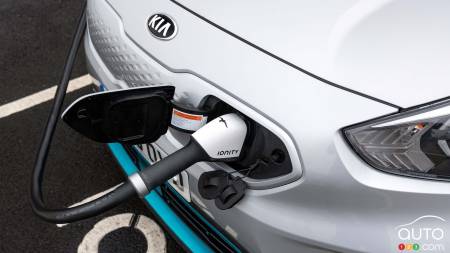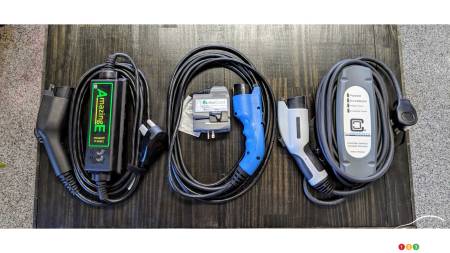Auto123 puts the Kia Niro EV to the long-term test. Today, part 16.
In our previous meeting, I started to cover what you need to know when shopping for the home charging station that best suits your needs. First, we got to know the OBC (on-board charger), the indispensable friend of all EVs, which led us into the fascinating topic of amperage, one of the many fascinating topics that revolve around a charging station but also have the potential to put us to sleep faster than a politician’s speech.
With the technical details out of the way, let's get to the heart of the matter, that is, the selection criteria for your charging station. By the way, these criteria come from a handy “Comparison of residential charging stations” prepared by BEQ Technology that I thoroughly enjoyed thanks to the insights of Yannick Lemelin, customer service coordinator for that company, which aims to be an one-stop electric-mobility shop for consumers.
1 - The manufacturer
There are at least 10 manufacturers of home charging stations in Canada, including ChargePoint, Wallbox, FLO, EVduty, Techno EV and Unit Chargers. Personally, I'd favour Quebec-assembled charging stations, figuring that their design is more likely to take our winters into account than, say, something conceived and born in San Diego. Finally, make sure that the bollard is CSA or cUL certified (mandatory for an electrician to be allowed to install it in Quebec).
2 - Cable length
The maximum length is 7.6m (25 feet).
3 - Power
From 7.2 to 11.5 kW. Remember the relationship between the power of the terminal and the power of the OBC of your EV.
4 – Restricted access to the terminal
“Are you afraid of having your electricity stolen by your neighbor? Access control may be attractive, but considering the low cost of an hour of electricity in Quebec, it may not be worth it,” Yannick rightly asks. But still, if you want it, most Wi-Fi connected stations offer this security option.
5 - RFID card
The RFID card is another form of access control, like a smart card, but this technology is slowly becoming obsolete. “Today, your card is your smartphone that unlocks the kiosk,” says Yannick.

6 - Wi-Fi connectivity via application
Most stations can be controlled remotely via the application downloaded on your smartphone. This is very useful for checking the charging status from the comfort of your living room; for programming it during a time when the Hydro-Québec network is less busy (great for those of us with environmental concerns); and for knowing exactly how much “juice” your EV has consumed each month, each year.
“A ‘non-intelligent’ charging station is necessarily less expensive than others, but also less practical," says our expert, who can't resist adding an important clarification: “It's not the charging station that can remotely start the heating or air conditioning of your EV.” This little trick is done by the car's application, also downloaded to your smartphone.
It may also only be a matter of time before all terminals on the market are intelligent, given the rapid market expansion of EVs around the world. “In fact, Europe is already requiring that capacity, but not here. That said, the day is coming when charging stations will also be able to connect to other programs such as Hilo, Google Home or Alexa," says Yannick.
7 - Integrated nozzle and cable holder
All stations include a nozzle holder so that the nozzle tip doesn’t get left lying on the floor and risk being damaged. What’s more, a holder built into the station uses less wall space. If you also want to hang the cable itself and keep your garage or driveway nice and tidy, why not get a simple hose holder?
8 - Power sharing
You have an EV at home? That's great! But what will happen when your spouse and children also have their EV? To the traditional fights over the bathroom, we can already imagine adding fights over access to the charging gun! Of course, two independent electrical circuits, each serving a terminal, could be the solution, except that the capacity of your electrical panel (and your budget) is not unlimited. That's why it's a good idea to have a charging station that can share power: it starts by charging both EVs at the same time at half power and then, as soon as one battery is full, it focuses on the second.
9 - Adjusting the amperage
For those who already have an unused circuit but not enough power or who lack a little capacity in their electrical panel.
10 - Direct connection
The 240V wire installed by the master electrician from your electrical box is connected directly into your terminal.
11 - Connection with 6-50 and 14-50 plugs
This time, the electrician has connected the wire into one of the two following outlets: a NEMA 6-50 (welder plug) or a NEMA 14-50 (stove plug). Both receptacles are rated for a maximum of 50 amps. The terminal plug (attached nearby) plugs into one of them.
Why not a NEMA 14-30, dryer plug? You would only have 30A and possibly just 24A if you were to follow the electrical code which recommends not to exceed 80 percent of the capacity of the equipment. Those 24A would be below the current average on the market.
12 – Portable terminal
If you have both a house and a cottage, you can have the necessary plug installed at both residences and then move the terminal at your convenience. Initially, the portable terminal plugs into a 6-50 or 14-50 plug. But not all “pluggable” (as opposed to direct connection) hydrants are necessarily portable. They only disconnect so that you can occasionally use another device on the same outlet. “Note also that the portable terminal is not necessarily more expensive than the others, but that the addition of a plug definitely represents an additional expense... and an additional possibility of breakage,” says Yannick Lemelin.
13 - For indoor and outdoor installation
The BEQ comparison only indicates terminals that can work both indoors and outdoors. Since not all EV owners have a closed garage, this is a self-evident necessity. Practically all the stations on the market can be used outdoors, but some cables are less flexible when it’s cold enough that they freeze.
14 - The model
Manufacturers tend to give their various stations names that sound like they’re pulled straight out of the Star Wars universe. So have fun with that, and with choosing one the look of which you like.
15 - The warranty
Three years.
16 - The price
Roughly speaking, Level 2 residential charging stations cost about $950. In the BEQ comparison, prices range from $649 to $1,295. Obviously, the more the station features any of the options mentioned above, the more it will cost...
17 - Subsidies
We recently saw Quebec lower the incentive available for new and used EVs in its provincial budget, but good news for those in that province: the incentive for the purchase of a residential charging station has not been affected: up to $600 (but nothing for its installation, and that since 2019). In addition, about 20 municipalities in Quebec reimburse between $100 and $500 of the cost of the station/installation (I will come back to this issue of subsidies). Note that each province has its own subsidies in place (if they have them), so it’s worth checking out what you may be eligible for in your home province and in your municipality.
Now that you have all this great info in hand, I wish you good shopping!
Specifications sheet of KIA Niro EV

See also: Kia Niro EV Long-Term Review, Part 1: The carmaker, the reviewer and the (young) enthusiast
See also: Kia Niro EV Long-Term Review, Part 2: Electric cars, a new idea with a long history
See also: Kia Niro EV Long-Term Review, Part 4: Getting a charge out of charging
See also: Kia Niro EV Long-Term Review, Part 5: Many kilometres, many questions
See also: Kia Niro EV Long-Term Review, Part 6: When the computer decides things, without consulting us
See also: Kia Niro EV Long-Term Review, Part 7: Off to Join the Electric Circuit
See also: Kia Niro EV Long-Term Review, Part 8: The Benediction
See also: Kia Niro EV Long-Term Review, Part 9: Beating the Cold
See also: Kia Niro EV Long-Term Review, Part 10: Let’s Talk Maintenance
See also: Kia Niro EV Long-Term Review, Part 11: Questions… and Answers
See also: Kia Niro EV Long-Term Review, Part 12: All About Nozzles
See also: Kia Niro EV Long-Term Review, Part 13: Station to Station
See also: Kia Niro EV Long-Term Review, Part 14: The Cost of Charging
See also: Kia Niro EV Long-Term Review, Part 15: How to Pick Your Home Charging Station (1 of 2)


